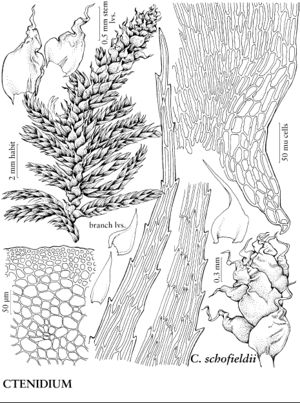Difference between revisions of "Ctenidium schofieldii"
J. Hattori Bot. Lab. 58: 27, fig. 10. 1985.
FNA>Volume Importer |
FNA>Volume Importer |
||
| Line 12: | Line 12: | ||
}}{{Treatment/ID/Special_status | }}{{Treatment/ID/Special_status | ||
|code=F | |code=F | ||
| − | |label= | + | |label=Illustrated |
}} | }} | ||
|basionyms= | |basionyms= | ||
| Line 40: | Line 40: | ||
-->{{#Taxon: | -->{{#Taxon: | ||
name=Ctenidium schofieldii | name=Ctenidium schofieldii | ||
| − | |||
|authority=N. Nishimura | |authority=N. Nishimura | ||
|rank=species | |rank=species | ||
| Line 54: | Line 53: | ||
|publication title=J. Hattori Bot. Lab. | |publication title=J. Hattori Bot. Lab. | ||
|publication year=1985 | |publication year=1985 | ||
| − | |special status=Endemic; | + | |special status=Endemic;Illustrated |
| − | |source xml=https://jpend@bitbucket.org/aafc-mbb/fna-data-curation.git/src/ | + | |source xml=https://jpend@bitbucket.org/aafc-mbb/fna-data-curation.git/src/f50eec43f223ca0e34566be0b046453a0960e173/coarse_grained_fna_xml/V28/V28_809.xml |
|genus=Ctenidium | |genus=Ctenidium | ||
|species=Ctenidium schofieldii | |species=Ctenidium schofieldii | ||
Revision as of 21:17, 16 December 2019
Stems 5 cm. Leaves at stem apices usually weakly curved to falcate-secund, unevenly divergent. Stem leaves 1–1.5(–1.7) mm; margins weakly denticulate; apex acuminate from mid leaf; laminal cells 50–80 µm, weakly prorulose. Branch leaves with margins recurved basally.
Phenology: Capsule maturity unknown.
Habitat: Soil, rock, cliffs, humus, canyons
Elevation: low to moderate elevations
Discussion
Ctenidium schofieldii is restricted to Queen Charlotte Islands, British Columbia and Adak Island, Alaska.
Ctenidium schofieldii is somewhat larger than C. molluscum, with longer medial laminal cells. The plants have an unkempt appearance in comparison with the usually finely combed leaf stance of C. molluscum. The apices of branch leaves are commonly irregularly divergent due to their more squarrose leaf bases, but may be evenly falcate-secund on some branches. In some collections, stem leaves and leaves at stem apices are flexuose-rugose though no cause (infection, insect involvement) is evident.
Selected References
None.

